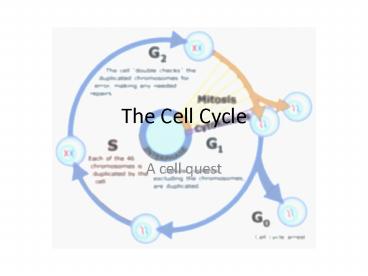The Cell Cycle - PowerPoint PPT Presentation
1 / 21
Title:
The Cell Cycle
Description:
The cell cycle is the cycle a cell goes through in order to make additional cells. Growth Replacing dead/worn ... The process is different in plants and animals V ... – PowerPoint PPT presentation
Number of Views:81
Avg rating:3.0/5.0
Title: The Cell Cycle
1
The Cell Cycle
- A cell quest
2
I. Cell Cycle Purpose
- A. The cell cycle is the cycle a cell goes
through in order to make additional cells. - Growth
- Replacing dead/worn-out cells
- Healing wounds
- B. The Stages of the cell cycle are
- G1 (Gap 1)
- S (Synthesis)
- G2 (Gap 2)
- M (Mitosis)
- Cytokinesis
3
II. DNA Packing
Tightly coiled DNA contains genetic information
Two identical parts of a chromosome sister
chromatids
Holds sister chromatids together at the center
Chromatin
Loosely coiled DNA wrapped around histones
4
Cell Cycle Wheel
5
III. Interphase
- G1, S, and G2 are all part of interphase.
- G1- During G1 the cell grows in size and collects
all the enzymes needed for Synthesis. - S- During Synthesis genetic information inside of
the cell doubles to create two sets of identical
chromosomes. DNA replication - So if a cell normally has 23 pairs of chromosomes
(like us!) after S-phase it has 46 pairs. - G2- In G2, the cell produces microtubules, which
are needed for mitosis
6
III. Interphase
7
IV. Mitosis
- Mitosis is the division of one mother cell into
two identical daughter cells. - The phases of mitosis are prophase, metaphase,
anaphase, and telophase.
8
A. Prophase
- Spindle Fibers form
- Centrioles move to opposite poles
- Chromosomes become visible
9
B. Metaphase
- Chromosomes line up along the equator
10
C. Anaphase
- Chromosomes divide
- Chromatids seperate and move to opposite poles
11
D. Telophase
- Nuclear membrane forms around each group of
chromosomes - Chromosomes unwind
- Cytokinesis begins
12
V. Cytokinesis
- The process by which the cytoplasm divides and
one cell becomes two individual cells. The
process is different in plants and animals
13
V. Cytokinesis
- Animals - cell membrane pinches inward
- Plants - a new cell wall forms between the two
new cells
14
Cell Cycle Wheel
15
VI. What stops cell from growing?
- Touching neighbor cells.
- Cells in a petri dish will continue to grow until
they come into contact with other cells. - Similarily, skin around a wound stops to grow
when it contacts other skin cells
16
Which chemicals regulate the cell cycle?
- A protein called cyclin regulates the timing of
the cell cycle and causes cells to divide.
17
How do cells respond to contact with other cells?
- Normally, cells stop growing when they come into
contact with other cells
18
VII. How are cancer cells different from other
cells?
- Cancer cells do not respond to cyclins that
regulate the growth of most cells. - Cells divide uncontrollably and form masses of
cells called tumors - The disease cancer results from these cells not
performing their normal jobs - Thought to be caused by a mutation on gene p53
- p53 blocks cell maturation in damaged cells.
- apoptosis
19
Lung Cancer
20
Oral cancer (tobacco chewing)
21
Cancer Treatment
- Surgery to remove cancer
- Chemotherapy
- Radiation
- Viral Vector































